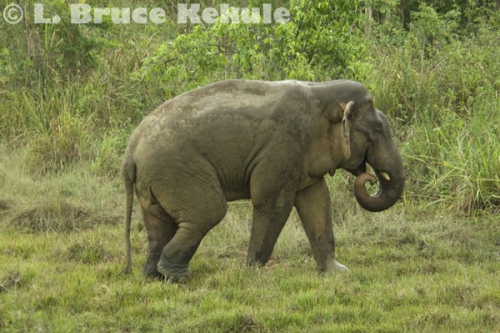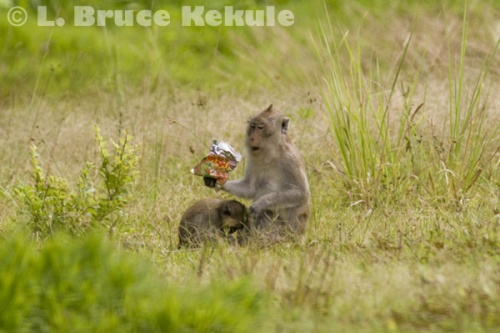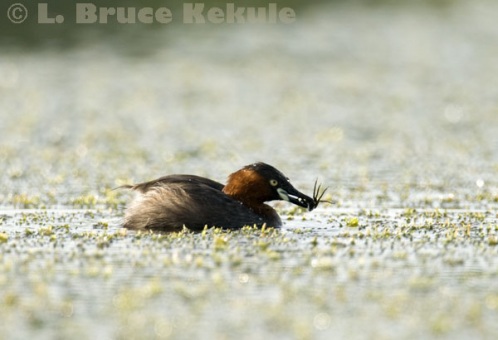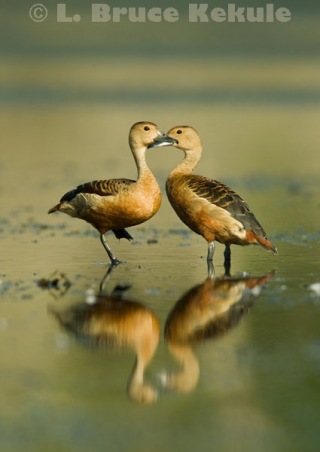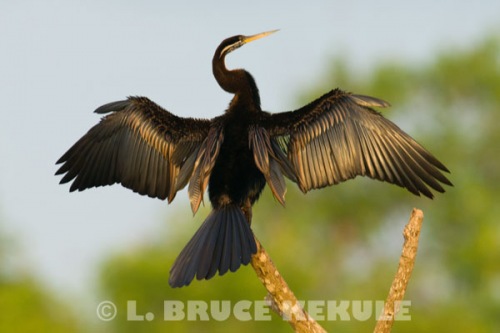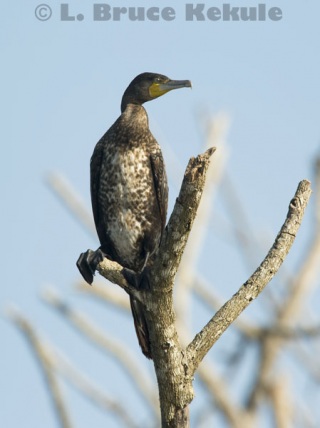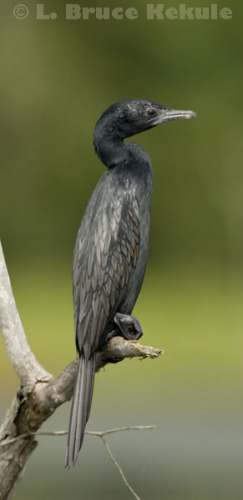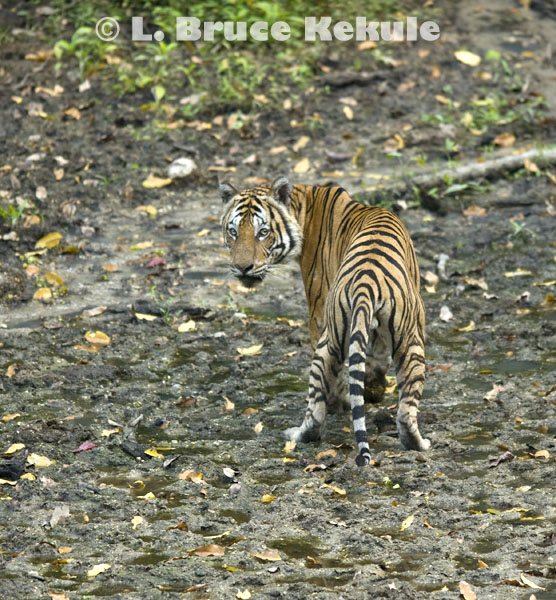Archive for July, 2017
Natural splendor in the East
THIS POST IS THE FIFTH IN A SERIES OF WILDLIFE STORIES THAT WERE PUBLISHED IN THE BANGKOK POST. Test and photos by © L.Bruce Kekule
Thailand’s largest remaining tract of lowland evergreen rainforest
A male Siamese crocodile in Khao Ang Rue Nai Wildlife Sanctuary, Eastern Thailand…!
During mid-morning at a secluded murky stream deep in the Eastern evergreen rainforest, a single reptile glides effortlessly through the water to a favorite basking spot. Lying on the bank some three meters long, this freshwater Siamese crocodile warms-up in the bright sunlight. Judging from the many photographs taken of this individual, it is a mature animal. It is thought to be male as no egg nests have ever been found here. Actual age is not known, but it has been here for quite sometime. The habitat consists of several connecting deep pools with abundant fish stocks. The crocodile occasionally takes small mammals and birds. It is a lucky but lonely survivor.
A pair of Lessor whistling ducks showing off on a floating piece of wood…!
Khao Ang Rue Nai Wildlife Sanctuary is home to probably the last truly wild Siamese crocodile in eastern Thailand. There are just a few surviving in nearby Cambodia but their future is threatened by the construction of hydroelectric dams. Since Siamese crocs can live for 60-70 years, it is hoped this individual will be in Khao Ang Rue Nai for some time to come.
Kitti Kreetiyutanont, a forest official working in the sanctuary years back, recorded the first sighting of this individual in 1987 by photograph. The croc still survives to this day, and is a tribute to the tenacity and longevity of the species. However, it is a case in point where humans are to blame for the disappearance of these remarkable creatures, from the lowlands all the way up into deep forest; by encroachment, poaching and logging that went on for decades.
Bull elephant on the move…!
Some 230 million years ago judging from fossil evidence, the first crocodilians evolved from the Archosaur. Crocodiles have outlived the dinosaur but here in Thailand, the demise of the wild species is close at hand. In the past, crocodiles were found in just about every main river system throughout the Kingdom. Modernization has brought these mystical creatures to the brink of extinction. They were mainly captured to stock crocodile farms, and were also killed by the people who mostly feared these shy reptiles. With no laws in place at the time to protect them, extinction was imminent.
Banteng herd moving to a waterhole in Khao Ang Rue Nai…!
However, a reintroduction program could be implemented here, and with increased protection, could work to save the remarkable Siamese crocodile from extinction in the wild. There are several other sites that can also be used for reintroduction such as Yot Dom National Park in Ubol Ratchathani province, and Phu Khieo Wildlife Sanctuary in Chaiyaphum province where crocs were once common. Over in the west of Thailand in Kaeng Krachan Natonal Park, one female is found in the Phetchaburi There are thousands upon thousands of crocodiles in farms, mostly by crossbreeding and hybridization. A wild population is the only option. A few of the crocodile farms still have
Banteng herd at the waterhole…!
Siamese crocodiles taken from the wild and could easily start a program to save the species. There has been one attempt at a national park to release crocodiles but it apparently was abandoned. Also, several Siamese crocodile have mysteriously showed up at Khao Yai and Thung Salang Luang national parks and believed to have been released clandestinely. These crocodiles should be captured and DNA checked to see if they are truly wild crocs.
Banteng cow with a lame right rear leg…!
Khao Ang Rue Nai is situated in the provinces of Chanthaburi, Prachin Buri, Chachoengsao, Chon Buri and Rayong. The sanctuary headquarters is located about three hours drive from Bangkok and was established in 1977 by Royal Decree. The protected area consists mainly (80 percent) of dry-evergreen forest with moist and hill evergreen, dry dipterocarp and mixed-deciduous forests interspersed with many streams, and are eastern Thailand’s largest remaining tract of lowland evergreen rainforest in the country. An annual rainfall of some 3,000 to 4,000 millimeters (118-160 inches) has been recorded.
Mother elephant and her young infant…!
The sanctuary is 1030 sq. km (398 sq.miles) in area and is part of the Prachinburi floodplain. It is the largest protected area of the Eastern Forest Complex, which includes four national parks and three wildlife sanctuaries: included are Khao Chamao – Khao Wong, Khao Khitchakut, Namtok Phlio and Khlong Kaeo national parks, and Khao Soi Dao, Khlong Khrua Wai Chaloem Phrakiat and Khao Ang Rue Nai wildlife sanctuaries. Unfortunately, these protected areas are mere islands in a sea of humanity.
Red jungle fowl (Eastern sub-species) breeding pair…!
In the old days, the Eastern Forest Complex was known as the Phanom Sarakham forest, and was one of the richest forests in Thailand famed for its abundant flora and fauna covering an area of about 8,000 square kilometers. Just a short 50 years ago, this dense, lush and vast jungle was home to large herds of elephant, gaur and banteng. Tigers and Asian wild dogs were common as were most of the smaller mammals like sambar, serow, wild pig, and muntjac (barking deer). Hornbills and gibbons, indicator species of an intact forest, thrived. But that quickly shrank as the human population expanded in causing irreversible damage to the ecosystems.
A Variable squirrel early one morning in the sanctuary…!
Due to its close proximity to Bangkok and other cities, many city hunters entered this forest at night spotlighting, either on foot or by jeep. This decimated the wildlife as everything was taken without regard for species, sex or age. The most damaging was the eight 30-year logging concessions carried out by logging companies that cut many roads into the forest. This alone-allowed easy access to virgin forest and it was not long before most everything vanished. In the meantime, this wilderness was also completely surrounded by agricultural land, which also took its toll.
Crab-eating macaque eating ‘mama’ dried noodles found in a trash can…!
Fortunately, and before it was too late; enough forest was saved so that the mammals and others were able to survive to the present. Although populations of the large herbivores have declined, they can be still be seen at various sites within the sanctuary. Unfortunately, the tiger has disappeared but a few Asian wild dogs still roam the interior and are at the top of the food chain.
Little grebe foraging for food in the reservoir…!
In 1967 when the Vietnam War was in full swing, the government cut many new roads through the forests in eastern Thailand supposedly to facilitate movement of US personnel and equipment from Utapao Airbase to other airfields in the Northeast. At the end of the Cambodian civil war in 1986, the Thai Army made one such road through the top half of Khao Ang Rue Nai. The impact of the road on this forest and the animals has been devastating and many creatures have been killed or maimed by vehicles on this thoroughfare.
The research unit stationed at Khao Ang Rue Nai on road-kill, deer and bovid population, elephant management and jungle fowl has carried out much research. Most accidents happened from 6pm to 6am. After much publicity, the road is now closed from 9pm to 5pm everyday and road-kill has dropped 70-80 percent. This is a plus for conservation where like-minded people have taken action to help prevent further carnage of wild animals.
Lessor whistling ducks…!
A total of 132 mammal, 395 bird, 32 amphibian and 107 reptile species have been recorded. Thousands of plant and insect species are found. Birds such as the black-and-red broadbill and the Siamese Fireback thrive. The rare woolly-necked stork and lesser adjutant once lived in these forests but have not been seen for sometime and are presumed extinct locally.
Oriental darter drying out its wings…!
Rare water birds like the Oriental dater and great cormorant migrate here and stay for several months at a reservoir built near the headquarters. This water source was created for the elephants during the dry season hoping to help eliminate human-elephant conflict. The marauding giants in search of food and water have killed and hurt many people. There are also recent reports of foraging gaur attacking farmers outside the sanctuary by mostly young bulls kicked out of the herd.
Oriental darter resting on a tree stump…!
The dangers facing Khao Ang Rue Nai are now severe as poachers and farmers snare indiscriminately. Cheap and simple rope snares have killed many elephants, gaur and banteng plus many other mammals. The villagers say they are protecting their crops. But many areas are in close proximity to the forest and interaction between wild beast and humans is a serious problem for the National Parks, Wildlife and Plant Conservation Department, who are constantly under pressure from these conflicts. More personnel and protective management plus a bigger budget are needed to protect these forests.
Great cormorant and little cormorant…!
Great cormorant…!
Little cormorant…!
But it must also be understood by the general public that wildlife sanctuaries are not open to the general public and have been set aside for species conservation, protection and bio-diversity research. Unlike national parks, recreation is not encouraged although it does occur, especially at waterfalls and viewpoints. Needless to say, the future of all conservation areas in the Kingdom is in the balance, and only increased protection, conservation awareness and education are the keys to sustain Thailand’s wonderful natural heritage.
Sunrize at the resevoir in Khao Ang Rue Nai Wildlife Sanctuary…!
Notes from the field:
For capturing images of such elusive creatures like crocodiles and elephants, infrared camera-traps are a very productive alternative to endless days of sitting in a hot photo-blind. Crocodiles are creatures of habit, so I set a camera-trap at its favorite basking spot by Klong Takrow. The croc was caught on film many times during a two-week session. One frame shown below was taken in early morning light. It seems as if the crocodile is smiling, and saying, “I’m right here”. I was elated to get such a lucky shot.
Siamese crocodile camera-trapped at Klong Takrow deep in the sanctuary…!
Khao Ang Rue Nai is currently home to about 130 wild elephants. The road transects the northern part straight through old elephant habitat. The narrow road was widened and resurfaced allowing faster speed. In 2002, a man and woman in a pickup truck barreling through the sanctuary at high speed did not see the elephants on the road until it was too late. The truck crashed head-on into a 5-year-old tusker. The truck’s driver was killed on impact but the woman survived. The young elephant died shortly after.
This unfortunate little tusker was killed on the road two-weeks after this camera trap shot at a waterhole in the interior…!
A tusker camera trapped at a waterhole in the sanctuary…this huge bull has killed a few poachers and villagers…!
The ironic circumstances of this accident – ancient animal and modern machine – weighed heavy in my heart. I had set camera-traps near the crocodile pond in the sanctuary a couple of weeks before. When the film was retrieved and processed, I was elated that a herd of elephants had triggered one of the cameras producing several frames. One frame showed an inquisitive little tusker looking straight at the camera. My elation quickly subsided a few days after the terrible news on TV and newspaper reports that a small tusker had been killed in the sanctuary. My worst fears were confirmed after consultation with Royal Forest Department officials and comparing photographs. A scar on the dead calf’s forehead proved it to be the same animal that I had ‘camera-trapped’.
Such accidents are a terrible blow to the conservation of Thai elephants, because tuskers are particularly vulnerable, being subject to hunting for their ivory. This young tusker was not the first and probably not the last elephant killed by reckless driving on this road. However, the Royal Thai Army and the Department of National Parks should be commended for taking the initiative by partially closing the road at night.
It is hoped that one day the time will be extended from 6pm to 6am to increase the animal’s chances for survival. This is the logical step and humans using this road would have to adjust to the new times for the sake of saving the wildlife.
Published in the Bangkok Post on May 25, 2009 in OUTLOOK – Nature section…’THE WILD SIDE’….!
The River Runs Wild…!
THIS POST IS THE SECOND IN A SERIES OF WILDLIFE STORIES THAT WERE PUBLISHED IN THE BANGKOK POST. IT IS ABOUT THE FIRST EDITION OF MY THIRD BOOK TITLED ‘WILD RIVERS’
Photographic book focuses through the lens of Thai national heritage on five rivers
By: PANYAPORN PRUKSAKIT
A culmination of 12 years work and including a selection of more than 300 photographs, Bruce Kekule’s Wild Rivers is truly a photographic odyssey. From the front cover, graced by the Asian tapir, an animal so rare it is considered a living fossil, one feels like this will be a truly special read. Kekule’s 20 years’ experience as a wildlife photographer, trekking and again through Thailand’s jungles, is invaluable to his epic undertaking, this his third book.
An old banteng bull and cow at a waterhole in the Western Forest Complex of Thailand
Kekule calls this a continuation of his dedication to the “Thai Natural Heritage” with Wild Rivers dedicated to His Majesty the King on his 80th birthday anniversary. On why he chose these particular rivers – the focus of this book is on fiver rivers: The Phetchaburi. Huai Kha Khaeng, Mae Klong, Khwae Noi and the Mae Ping – Kekule remarks the main reason was that they still have wildlife left, he says, as humans have been relentless in their expansion and development plans on other waterways.
Having lived in Thailand for over 40 years, he says that these rivers and the surrounding jungles are some of his favorite places in the country. A rather spiritual man, he recalls how the inspiration for his series of wildlife photography books came to him in a dream. Kekule’s passion for his career of choice is evident – one of his favorite quotes is by the Chinese philosopher Confucius, that one should choose a job you love and you will never have to work a day in your life.
An Oriental Dwarf Kingfisher in Kaeng Krachan National Park, Southwest Thailand
From the opening pages of Wild Rivers, it is clear that Kekule not only seeks the natural beauty of Thailand’s rivers with the reader, but also to inform and educate about these “natural treasures”, as he calls them. As Kekule states in his forward, “without water, there would be no life.” The book begins with a history of Thailand’s formation, and the importance of Thailand’s rivers – what Kekule calls “the lifeblood of the nation”…(as) plants, animals and humans carry out (their) daily lives dependent on water.”
Kekule’s extensive experiences is evident in the clarity, sharpness and vivid colors which define all of his photographs. But what makes Kekule’s shots truly spectacular is that the animals he captures on film are truly in their natural habitat, almost unaware of his presence.
Equally as rivetingas the photographs, which fill the book is the narration from Kekule himself, about his adventures while writing the book. Entitled “notes from the field”, he tells of his encounters with rare creatures such as the king cobra. These stories are both endearing and amazing at the same time – he recalls how he “felt extremely happy at helping to save this beautiful bird of prey from dying,” upon finding an “owl going into shock from hypothermia” and using the campfire to warm-up this creature from a certain death.
Wild pig along the river in Huai Kha Khaeng Wildlife Sanctuary
Kekule seems to have had more than his fair share of luck – indeed he concedes that he has been luckier than most other wildlife photographers, in coming upon rare animals such as the Asian tapir in the daytime. They are primarily nocturnal and hardly seen in the day, let alone photographed with good light. But he believes strongly in the “spirits of the forest”, whom he believes guide and help him. He writes how he pays his respects to the spirits – always before eating.”
However, Kekule’s career as a wildlife photographer has not been without its occupational hazards. He recalls in his book how he “became ill with the deadly Plasmodium falciparum (celebral malaria) that almost killed [him].” Kekule states that only a “medical procedure practiced here in Thailand for patients with severe malaria called a blood exchange transfusion” saved him. While he comments that he was lucky to survive”, even this experience has not kept him from capturing the wildlife of Thailand. However, he now takes some wise precautions that he did not previously adhere to, such as not photographing in the monsoon season.
Wild Rivers – 1st Edition dedicated to His Majesty the King on his 80th birthday anniversary
Kekule states how he will continue with his career for as long as he “can hold a camera and walk”, such is his determination. The most gripping and urgent message of Wild Rivers is found in the penultimate section of the book, entitled “Wildlife in Peril: Dangers threatening the natural world”. Kekule writes about how Thailand’s ecosystems are being progressively destroyed by encroachment, poachers, the black market and the traditional Asian medicine trade. He also writes how education and aid for local village Thais and hill tribe people is needed as middlemen “flash money at the people who are mostly poor and easily persuaded to break the law in order to feed this voracious [black market] trade.” Kekule outlines a step-by-step plan for the government, for “taking care of the natural resources” of Thailand, which included suggestions about budgets and addressing grassroots problems.
Kekule’s love of Thailand as a nation, and the setting for his wildlife photography adventures, is evident in every page of Wild Rivers. He hopes that his books will serve as part of education, which must be implemented in Thai schools to change the mentality towards wildlife and nature, and promote their conservation rather than their destruction. The stunning beauty of Kekule’s book and its important message can certainly not go unnoticed, if only because of the great artistry it showcases. But perhaps the reader can also take away Kekule’s message that “all humans have a right to exist, but unfortunately, not at the expense of the natural world.”
Published in the Bangkok Post’s Outlook Section on November 10, 2008. The photos shown were actually used in the newspaper article when it was published.
LAST OF WILDLIFE TRIOLOGY
THIS POST IS THE THIRD IN A SERIES OF WILDLIFE STORIES THAT WERE PUBLISHED IN THE BANGKOK POST. WRITTEN BY USNISA SUKHSVASTI
LAST OF WILDLIFE TRIOLOGY
Male Indochinese tiger at a water hole in the Western Forest Complex
Wild Rivers: A Photographic Odyssey in Thailand is the third in a series of wildlife books — the first two were Wildlife in the Kingdom of Thailand and Thailand’s Natural Heritage – by L. Bruce Kekule, respected wildlife photographer and long time resident of Thailand. His books follow a pattern; First is an English-language edition, followed by a Thai language one.
Wild Rivers (1st Edition) was published in 2008, as dedication to His Majesty the King on the auspicious occasion of his 80th birthday, and the Thai edition (2011) recently out at the same time as the second-edition of the English version, dedicated to His Majesty the King on his 84th birthday, with the aim of sharing the beauty of the country’s natural heritage and its wildlife with the Thai people.
Wild Water Buffalo in the Huai Kha Khaeng River
The book covers six of Thailand’s major waterways: The Phetchaburi River, Khlong Saeng River (a new addition to the first edition), Huai Kha Khaeng, Mae Klong River, Khwae Noi River and the Mae Ping River.
The introduction describes the geographical locations of each river, emphasizing as always the importance of preserving these watersheds and the habitat for resident wildlife.
Black-and-red broadbill in Kaeng Krachan National Park
Each river is illustrated with photographs that he has collected from his forays into the wild over the past 12 years, allowing readers to admire the country’s wild animals in their natural habitat.
The book also includes a chapter on Thailand’s nature photographers where 1o Thai photographers and one foreign photographer have shared some of their most cherished images.
In the ‘Wildlife Photography’ chapter, Kekule shares tips and personal experiences gained from his decades in the field, his choice of equipment, the need for patience, the art of stealth, camera techniques, and even computer skills. He also mentions the hazards and dangers of being in the field, not only threats from large animals but also from the tiniest of creatures like ticks, ants and mosquitoes…!
He ends with a plea for nature conservation in ‘Wildlife in Peril’ to create awareness among readers to the diminishing numbers of animals in the wild due to human ignorance or greed.
Wild Rivers – 2nd Edition dedicated to His Majesty the King on his 84th (7th Cycle) birthday
Wild Rivers – Thai Version (1st Edition) also dedicated to His Majesty the King on his 84th (7th Cycle) birthday
Readers can be sure of a visually pleasing read. Wild Rivers received a gold medal for the “Best in Sheet-fed Offset” and another gold award for “Best 4-color Printing” at the Thai Printing Association’s 4th Thai Print Awards in 2008.
The Thai version titled ‘Sai Natee Haeng Pong Prai was translated by Capt. Araya Amrapala, PhD.
Note: The photos shown here were actually used in the newspaper article when it was published.




